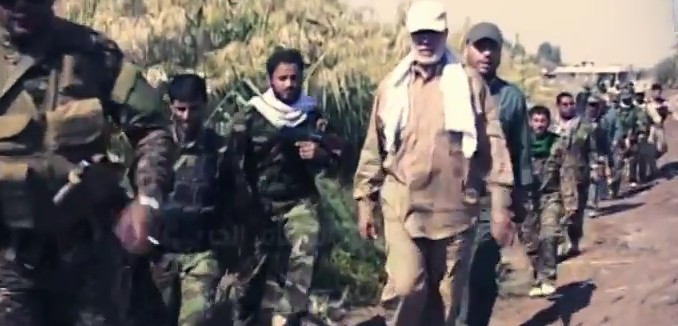The United States will be housing American troops at the same Iraqi base that Iran-backed Shiite militias will be using, Josh Rogin and Eli Lake reported for Bloomberg View today.
Two senior administration officials confirmed to us that U.S. soldiers and Shiite militia groups are both using the Taqqadum military base in Anbar, the same Iraqi base where President Obama is sending an additional 450 U.S. military personnel to help train the local forces fighting against the Islamic State. Some of the Iran-backed Shiite militias at the base have killed American soldiers in the past. …
The U.S. gives weapons directly only to the Iraqi government and the Iraqi Security Forces, but the lines between them and the militias are blurry. U.S. weapons often fall into the hands of militias like Iraqi Hezbollah. Sometimes the military cooperation is even more explicit. Commanders of some of the hardline militias sit in on U.S. military briefings on operations that were meant for the government-controlled Iraqi Security Forces, a senior administration official said.
This collaboration with terrorist groups that have killed Americans was seen as unavoidable as the U.S. marshaled Iraqis against the Islamic State, but could prove counterproductive to U.S. interests in the long term, this official said.
Rogin and Lake note that a number of the militias that will be sharing the base have previously targeted and killed American troops, including the League of the Righteous, which executed five American soldiers in 2007. A spokesman for the group has boasted that it was behind the deaths of even more American troops. The militias are headed by Abu Mahdi al-Muhandis, who was designated in 2009 by the Treasury Department for his role in destabilizing Iraq and “[posing] a significant risk of committing acts of violence against Coalition and Iraqi Security Forces.”
In addition, a number of these militias are accused of committing human rights violations and sending fighters to support the regime of Syrian President Bashar al-Assad.
Al-Muhandis, who has been accused of bombing the French and American embassies in Kuwait in 1983, is close to Iran’s Islamic Revolutionary Guard Corps Qods Force commander, Gen. Qassem Soleimani.
Despite the enmity of the militias towards the United States and the possible negative consequences of the alliance, The New York Times reported in March that the United States had become “increasingly dependent on Iranian fighters,” to combat the Islamic State of Iraq and Syria (ISIS).
In On This Battlefield, the U.S. and Iran Work Hand in Hand, which was published in the April 2015 issue of The Tower Magazine, Michael Pregent wrote:
CENTCOM statements that the U.S. is not coordinating directly with the IRGC and its proxy militias may be true, but I know from experience what channels are being used to pass IRGC-recommended targets to U.S. air forces: Iran-backed Shia militia commanders send them to Iraqi Security Force (ISF) commanders affiliated with the Iran-backed Badr Organization, who then pass them on to Ministry of Defense representatives in Joint Operations Centers (JOCs), where U.S. advisors place them in the targeting queue. After that, IRGC targets will be hit by U.S. bombs.
This is the pattern of target development I myself witnessed in Baghdad. In fact, we tried to stop it when we were trying to counter Iranian influence in Iraq. It is a method that works for the Iranians, because it is an effective way to pass sectarian targets through legitimate channels to U.S. advisors. Suleimani and his proxies know this. We should know it too. The truth is, Iran-backed Shia militias are now our eyes on the ground in Iraq.
It’s also important to remember what the ISF actually is: It is a predominantly Shia force, and heavily infiltrated by Iran-controlled proxy groups. The ground force in the current battle for Tikrit is largely composed of Shia militias operating as PMUs, led and commanded by Badr Corps commander Hadi al-Ameri. The Iraqi Security Forces number 5,000, while the PMUs stand at more than 20,000. There is no doubt that al-Ameri is running the show and there is no doubt that the IRGC is running him.
If, in fact, reports are true that Suleimani, Asaib Ahl al-Haq, and Kataib Hezbollah have all pulled out of Tikrit as a precondition for U.S. airstrikes, it means that we have somehow gained influence over Tehran that we haven’t had since 1979. It may also mean that Iran heard President Obama say that this proves Iran is failing in Iraq and is simply replying, “Let’s see if you can do this without us on the ground.”
Indeed, absent U.S. eyes and boots on the ground, we are essentially operating as an air force for Iran and its proxies. At the same time, the American advisory effort is trying to work with an Iraqi sectarian intelligence and security apparatus heavily influenced by Iran. In effect, the sectarian actors we once tried to sideline are now in charge of operations.
[Photo: Stahlgewitter Syrien / YouTube ]




